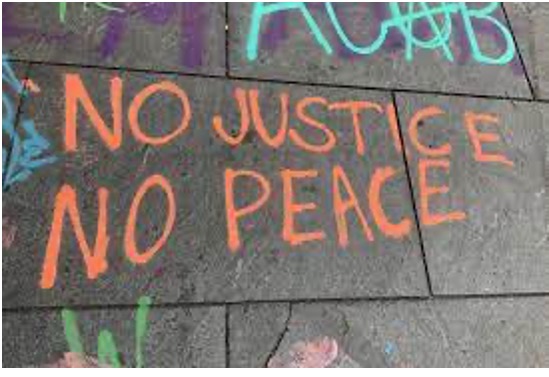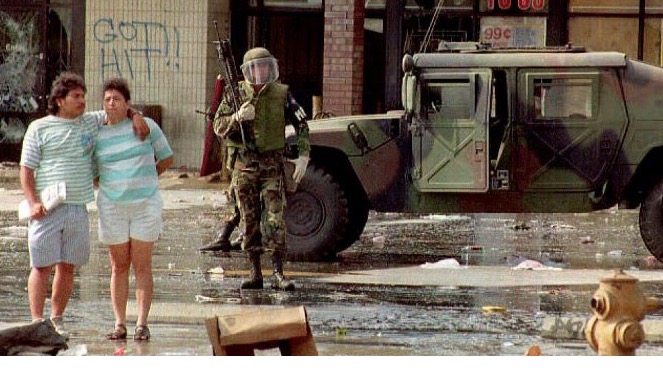CommentsPLANNING WATCH - The 30th anniversary of L.A.’s historic 1992 uprising ushered in long overdue press coverage of this nearly forgotten event.
Unless you lived through it and kept notes, the current press reports frame 1992 as a violent outburst of Black-Korean racial tension. This reinvention of history, however, ignores many basic facts:
-
The first evening -- on Thursday, April 29, 1992 -- consisted of organized multi-racial protests in downtown Los Angeles, beginning at LAPD headquarters and then fanning out other public buildings, as well as the headquarters of the Los Angeles Times. While the LAT published a detailed chronology of events between April 29 to May 4, 2002, the assault on its own building was not, apparently, newsworthy.
-
On Saturday, May 2, there were many racially and ethnically diverse political demonstrations in downtown Los Angeles.
-
“No justice, no peace” graffiti quickly spread across the entire Los Angeles basin. This is one reason that the May 7, 1992, issue of Newsweek described L.A.’s civil disturbance as a rebellion of the have-nots versus the haves. The New York Times later described it as “a multi-ethnic eruption of fury at the socioeconomic structures that excluded and exploited so many in Southern California.”

-
The uprising/civil disturbance/riot spread from South Los Angeles and Koreatown to Pasadena in the north, Long Beach in the south, Pomona on the east, and Venice on the west.
-
The L.A. uprising sparked similar events in San Francisco, San Jose, Seattle, Las Vegas, Atlanta, Tampa, and Washington, DC. Outside the United States, there was also an uprising in Toronto, Canada.
-
Over half of those arrested were Latino.
-
No one has been arrested and convicted for the uprising’s 54 murders, and the official blue-ribbon Christopher Commission report only examined LAPD practices, not the socio-economic context of the uprising.
If we combine this missing information with current trends, we can understand why so many local residents expect another uprising.
First, the homeless crisis is getting worse. The imaginary top-down cures, up-zoning ordinances to encourage private investors to build more market housing, make the affordable housing crisis worse.
-
This planning fix decreases the supply of existing lower-priced housing because of demolitions, while the new market-rate apartments pull up rents in remaining rent-stabilized. Up-zoning ordinances also widen economic inequality because they create windfall profits for owners and developers of commercial parcels.
-
These developments also draw in deep-pocketed real estate investors. They bid up residential values with generous cash purchases, pricing even more people out of housing.
Second, LA’s infrastructure and public services will continue to deteriorate. This lack of planning and maintenance results in a declining quality of life for Angelenos.
Third, police agencies and prisons will receive budget increases. Because planning policies, like up-zoning, cause homelessness, enlarged police departments are tasked with disbursing homeless encampments and stopping robberies, which the sensationalist media and NextDoor attribute to homeless people.
Fourth, U.S. military budgets will steadily grow because of bi-partisan support for NATO expansion and military confrontations with geo-political rivals Russia and China. As a result, less Federal money will be available for housing and health care.
Fifth, the climate crisis will stay on the back-burner, despite surging natural disasters and new scientific studies featuring five-alarm scenarios.
Opinion polls cannot tell us how the public is likely to respond to these overlapping trends because their reactions could take many forms:
-
Lone-wolf actions, such as pocketing office supplies or mentally ill employees going “postal.”
-
Months-long movements, such as the U.S. Occupy Movement encampments of 2011 and the Black Lives Matter nationwide demonstrations of 2020.
-
Short-lived uprisings, such as New York City’s 1863 draft “riots,” Tulsa’s 1921 massacre of 300 Black residents, hundreds of ghetto rebellions in the 1960s, and the six-day-long Los Angeles civil disturbance of 1992.
-
Long-term, politically-organized mass movements, such as the Wobblies/IWW from 1905-1924, large scale CIO union-organizing movements in the 1930s and 40s, the Ban-the-Bomb movements of the 1950s, the anti-Vietnam War movements of the 1960s and early 1970s, the Civil Rights movement from the 1950s to 1970s, the anti-nuclear movement of the 1970s and 1980s, and the Women’s and LBGTQ movements from the 1960s to date.
-
Mass movements that become revolutions, such as the Paris Commune in 1871, the little known Louis Commune of 1877, the Russian Revolution of 1917-1991, and the Chinese Revolution from 1948 to date.
History is full of unexpected twists and turns, but there is increasing evidence that governmental authorities are not waiting for political threats to unexpectedly flair up. Police budgets are steadily increasing. Mass incarceration has placed 2,300,000 people behind bars and another 4,600,000 on parole or probation. Surveillance now includes extensive government agencies spying on snail mail, phone calls, email, texts, and websites.
Will responses like these, that try to anticipate the emergence of civil unrest and spontaneous revolts prevail? No one knows because just as techniques of political control have become more sophisticated, so have options for organizing opposition and resistance.
Furthermore, movements in one country can quickly spark events in faraway lands. This happened in 1968 in places as different as the United States, UK, Vietnam, France, Mexico, Poland, Czechoslovakia, Yugoslavia, Italy, Germany and Japan. They happened at nearly the same time -- before social media – and indicate the possibility of unexpected political events quickly spreading throughout a world electronically linked across national borders.
While public opinion polls can hardly predict the future, they can educate us about broad trends, so stay tuned. Like 1992, history is more than a spectator sport.
(Dick Platkin is a former Los Angeles city planner who reports on local planning issues for CityWatchLA. He serves on the boards of United Neighborhoods for Los Angeles (UN4LA) and the Greater Fairfax Residents Association. Previous Planning Watch columns are available at the CityWatchLA archives. Please send questions and corrections to [email protected]) .















